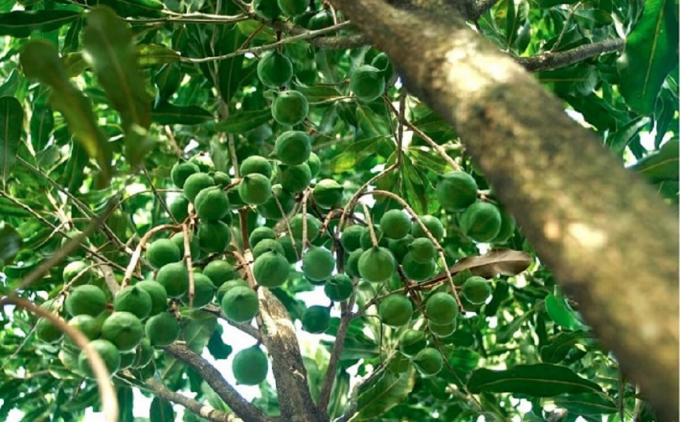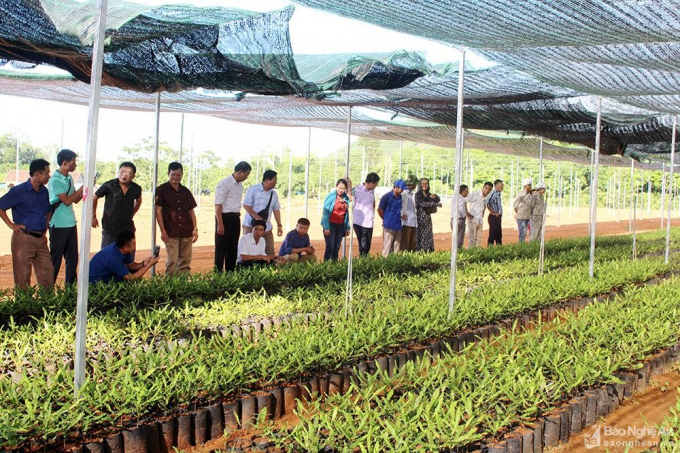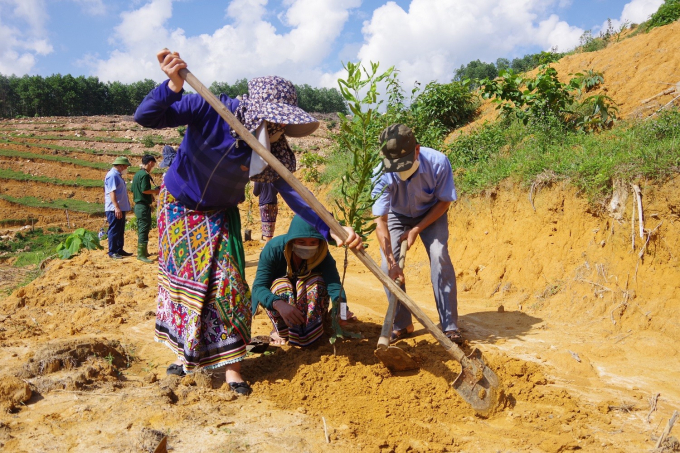Vietnam’s first macadamia shipment sent to Japan
HCMC – Krong Nang District in the Central Highlands province of Dak Lak transported a container of macadamia
Macadamia trees are grown in the Central Highlands, with good results and very high yields in many locales. Photo: VAN.
It is unpractical to rely solely on the properties and values of the macadamia tree as demonstrated in books, in the mass media as well as in the results of other provinces to see it as a great opportunity for the development of macadamia trees in the Western region of Nghe An. The development of macadamia trees in Nghe An must be based on sufficient scientific basis before the province can expand its macadamia growing areas to a larger scale.
In terms of science, before putting a crop into agricultural production, it is necessary to go through the every steps of the process; from trial research to trial production on a narrow scale to monitor and evaluate the criteria for growth and development over time in each season, on different types of soil, as well as to assess the influence of climate and weather on growth, yield, product quality, pest resistance capacity and ultimately economic efficiency.
Farmers visiting a model of macadamia trees in Yen Hop commune, Quy Hop, Nghe An. Photo: TN-MT.
If the trial production provides good results, the macadamia growing area will be developed gradually in the form of demonstration models. Tours and workshops will also be organized to introduce the new plant before introducing a policy of expanding the scale for each specific location.
Macadamia is a new tree that not many people know about. It is a tall woody tree, native to Oceania (Australia), and belonging to the family Proteaceae. The tree has a wide canopy, shallow roots, white or pink flowers. Macadamia flowers bloom mainly from February to March, depending on the temperature of each different sub-climate.
Macadamia is a typical birch tree, the leaves grow in a round pattern; there are also cases where 2 leaves grow symmetrically or 4 leaves grow in a ring. Macadamia flowers are hermaphroditic, without petals (bare flowers). The fruit is dry, cylindrical in shape. The nut inside the fruit contains an oil similar to that of a cashew nut. Macadamia trees can be grown alone or intercropped on porous soil, with as deep the arable soil layer as possible. Macadamia is a tree with a life cycle of 90 to 100 years. Macadamia varieties are currently grown mainly by grafting, so they yield flowers and fruits after only 3 to 4 years.
Late Deputy Prime Minister Nguyen Cong Tan personally visited Nghe An in 2003 to direct the trial growing of macadamia trees at Song Hieu Forestry Company Limited and Con Cuong Forestry One Member Limited Company.
Macadamia trees are grown by several households in Nghia Lam commune, Nghia Dan district.
Mr. Ho Dinh The, former Director of Song Hieu Forestry One Member Limited Liability Company said that the company planted nearly 500 macadamia trees scattered along both sides of National Highway 48 trees from Nghia Dan to Quy Chau, Que Phong and 20 trees on the Company's ground in 2003.
After 3 years, every tree grows and flowers well. Every year, all of the trees flower from February to March. Unfortunately, although every tree flowers, they bear little to no fruit.
According to Mr. Ho Dinh The, the reason as to why macadamia trees flower but yield little fruit is because macadamia flowers are structurally bare. On the other hand, the flowering period from February to March in Nghe An and particularly in the western region of Nghe An is the rain season, accompanied by a prolonged northeast monsoon. The duration of rain and humidity washes away and destroys pollen, so the fruit setting rate is considerably low. Mr. Ho Dinh The said that macadamia trees have only been grown as protective forest trees, because the trees are green all year round. Macadamia trees grown for fruit as in the Central Highlands provinces and several provinces in the Northwest of Nghe An is not effective.
Mr. Nguyen Ngoc Lam, Director of Con Cuong Forestry One Member Limited Company (formerly Con Cuong Forest Group) during a visit to check the development, flowering and fruiting of macadamia trees.
Mr. Nguyen Ngoc Lam - Director of Con Cuong Forestry One Member Limited Company said: On October 7, 2003, Nghe An Department of Agriculture and Rural Development issued Official Letter No. 2221/CV-NN assigning the Company to grow macadamia trees in Con Cuong district, including: Planting on the company's land 4057 trees and planting 8000 trees in 6 communes (2000 trees in Mon Son commune, 1200 trees in Luc Da commune, 2000 trees in Yen Khe commune, 1000 trees in Bong Khe commune, 1,000 trees in Mau Duc commune). The total number of trees planted was 12,057 trees, which is equivalent to an area of 20 to 21 hectares. Most of the macadamia trees have flowered normally after 3 years of planting, but the fruit yield is inconsiderable.
As explained by Mr. Ho Dinh The, Mr. Nguyen Ngoc Lam believes that the reason as to why the local macadamia trees flowers a lot, but bears little fruit is the fact that the macadamia flowering season mainly lasts from February to March. In this period of time, Nghe An's weather is dominated by drizzles and prolonged northeast monsoon; the air humidity is high, and there is even frost in certain areas.
A delegation from Con Cuong district, Nghe An visiting the macadamia growing model in Thach Thanh district, Thanh Hoa in 2019.
Furthermore, macadamia flowers are bare without petals (similar to mango flowers). Therefore, when there is prolonged rain and high air humidity, the pollen will rot resulting in little to no fruit yield. In recent years, each macadamia tree yield only 5 to 6 kg of fruit. In more favorable weather, macadamia treecan yield up to 15 to 20kg of fruit. As a result, some macadamia trees have been cut down to be replaced with more effective trees.
As a basis to expand the macadamia area in Nghe An, Con Cuong Forestry One Member Limited Company prepared a report assessing the status of experimental as well as mass planting macadamia trees in 6 communes of Con Cuong district on April 1, 2019.
The report has concluded that: Macadamia trees have excellent potentials in Nghe An, but the flowering period and the fruits are not appropriate with the specific weather and climate in the province. Consequently, the economic efficiency of macadamia trees in Nghe An is very low; and that is why many areas of macadamia trees have been cut down to be replaced with more efficient trees.
According to Mr. Nguyen Van Lap, former Deputy Director of the Department of Agriculture and Rural Development, the monitoring of experimental macadamia trees in Nghe An shows that it is not effective and the province should not establish a policy to expand the macadamia tree area in Nghe An.
Macadamia is a plant native to the state of Queensland, Australia, in a temperate climate zone. Macadamia is not an easy plant to grow compared to rubber, coffee among others. Prof. Dr. Le Dinh Kha, who has been attached to the macadamia tree since its early days in Vietnam and has conducted numerous researches on the tree, recommends that: The value of macadamia trees has been greatly exaggerated as being an easy-to-grow, high-income tree in the past.
Con Cuong district People's Committee (Nghe An) organized for commune officials to visit and learn from the model of growing macadamia trees in Thanh My commune, Thach Thanh district, Thanh Hoa in 2019.
In many cases, people have rushed the expansion of the macadamia growing area in order to sell seeds. Macadamia is a very fastidious crop, it is not easily grown in any environment, requiring considerable investment as well as posing a lot of risk. Accordingly, Prof. Dr. Le Dinh Kha to not be careless and blindly follow the trend of growing macadamia. The only way to avoid risks is that before deciding to expand the growing area, it is necessary to plant an experimental plot and only when there are satisfactory results should the farmers consider expanding the area.
Prof. Dr. Hoang Hoe, former director of the Forest Investigation and Planning Institute, said that through various research results, macadamia trees can develop strongly in two Vietnamese regions, the Central Highlands and the Northwest. For the other regions, the macadamia trees bloom during the rainy season, so the trees have very limited yield.
Ms. Vo Thi Nhung, Deputy Director of Nghe An Department of Agriculture and Rural Development, said that macadamia trees have been grown in Nghe An for several years with an area of 200 hectares, but the statistics are unclear regarding efficient and inefficient location, high and low harvest, fruitful and fruitless trees. In general, the average productivity of macadamia trees in Nghe An is still very low and unstable. The reason, according to Ms. Nhung, is that the weather at the time of flowering is not favorable; and the intensive investment and care regime is not satisfactory.
Macadamia trees in Ngoc Lam commune, Thanh Chuong district, Nghe An in 2021.
In the near future, in order to have a scientific basis for the expansion of macadamia tree area in Nghe An, the Department of Agriculture and Rural Development will assign the Nghe An Center for Agriculture and Fisheries Extension to experiment with macadamia trees (both in terms of pure planting and intercropping planting with tea trees to serve as shade for tea). If the experiment proves to be successful, there will be a plan to gradually expand the macadamia area in accordance with the soil conditions, climate and investment capacity in Nghe An.
Based on the results of experimental macadamia planting in Con Cuong district and pther localities in Phu Quy area, scientists, managers, as well as the author of this article believe that there is not enough scientific and practical basis to bring macadamia trees into cultivation in Nghe An on a larger scale.
Arbitrary and hasty expansion of planting areas when there is not enough scientific basis has caused damage to both the state and the producers. Namely, the expansion of the Camellia and Rubber trees to low hills and semi-mountain areas in the past few years have cost the people dearly.
Translated by Nguyen Hai Long





